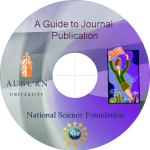

Cover Letter and Cover Page
Normally, the corresponding author will be one who sends the material to the journal (the paper files, figure files, cover letter, biographies, etc.) The corresponding author will normally be the author of the cover letter / cover email. Note that the current state of the publishing field is such that many journals use a totally online submission and review process while others still use ad hoc emailing of files and messages. If you are engaging an online system, you will be directed to enter information or upload files. If you are emailing the files directly to the editor then make sure you use a common format such as pdf or Word doc and descriptively label the file names.
On the paper itself, be sure to include all of the correspondence information for each author on the cover page: author's name as it should appear in print, affiliation, postal address, telephone and fax numbers, and e-mail address. If the journal uses a double blind procedure then this information will be deleted prior to being sent out for review.
- Contact the editorial office or journal website and give them your new email / address if you change any of these.
- No typographical errors in the cover letter / cover email!! This is a sign of disregard and is not a good way to begin your paper.
- Your cover letter should be no more than a couple of sentences. This will be read by the editor so be sure to state why you think your paper would be a publishable contribution to your field and/or the journal and why this journal would be a good home for the paper. Some journals may want to you to specify an area or division of the journal so that the paper is properly assigned to an area editor.
- Some editors like you to suggest reviewers. The editor may or may not use the reviewers. If you do suggest reviewers, make sure they are competent in your technical area, do not have a conflict of interest with you or the paper and will be responsible reviewers.
